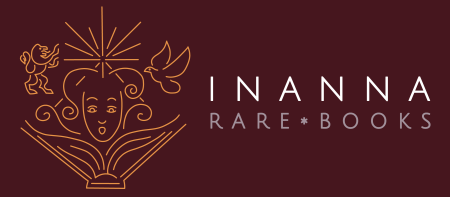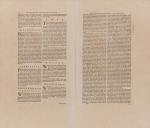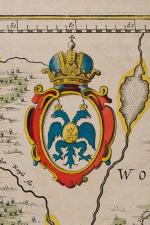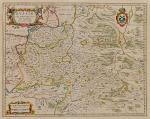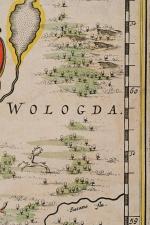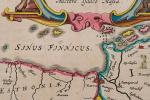Blaeu, Russiae, Vulgo Moscovia dictae, Pars Occidentalis.
Russiae, Vulgo Moscovia dictae, Pars Occidentalis. Auctore Isaaco Massa.
Original hand-coloured engraving. Amsterdam Blaeu, [c.1664]. Plate Size: 48.7 cm x 38.6 cm. Sheet Size: 65.2 cm x 55.7 cm. Original map. In very good, clean condition. Wide margins. Latin text on reverse.
[Koeman II, 1803:2.].
From: J. Blaeus Grooten Atlas, oft Werelt- Beschryving, in welcke ‘t Aerdryck, de Zee, en Hemel, wort vertoont en beschreven. Amsterdam, J. Blaeu, 1664. (Van der Krogt 2, 621).
Beautiful map of mid-17th Century Russia published during the reign of Tsar Alexis of Russia, of the Romanov Dynasty, as Moscow vied for regional hegemony with the Polish–Lithuanian Commonwealth and Sweden. ‘Mosqua’ (Moscow) is in the lower right corner. Smolesnsk is just squeezed in within the maps lower border. Novogorod can be seen just below the outflow of Lake Ilmen. In the upper left lies Estonia and the Gulf of Finland. Below this is the ‘Livonia’ region which is now between Latvia and Estonia. The regions listed as ‘Ingria’ and ‘Careliae Pars’ on the map were then under the control of the Swedes. The Russians would eventually seize this territory and dominance of the Baltic and build their new capital St. Petersburg there. This lay in the future. The map’s political delineation shows the westward extent of Moscow’s reach. ‘Lithva’ in the lower left of the map was then within the territory of Polish-Lithuanian Commonwealth. This region is now modern-day Belarus: ‘Witespk’ is now the Belarussian city of Viciebsk.
Relief depicted pictorially and the historic place-names are in Latin. The cathedral cities, such as Pereslaw (Pereslavl-Zalessky) and Ieroslaw (Yaroslavl) and Pseskow/Pskouwa (Pskov) are depicted. With numerous deers and foxes seen across the map, the mapmaker indicates that this is a vast region still untamed. In the ‘Megrina’ province the mapmaker shows a bear-hunt at its deadly denouement. The map is covered with forested areas and vast waterways such as the Volga and Volkhov and Daugava/Dvina (‘Duna flu’) Dnieper (Boristenis Flu) rivers and a patchwork of lakes such as Lake Peipus and ‘Biela Osera’ (Rybinsk Reservoir).
Large decorative title cartouche accompanied with busts of moose and deer in the left top corner of the map. The eagles of the Russian coat of arms look east and west from the top right corner of the map. In the lower left corner, an ornate cartouche contains two milliaria bar scales.
Blaeu, as it is noted on the cartouche, based the map on the travels and maps of Isaac Massa.
Isaac Abrahamszoon Massa (1586 – 1643) was a Dutch grain trader, traveller and diplomat, the envoy to Muscovy. He wrote memoirs related to the Time of Troubles and created some of the earliest maps of Eastern Europe and Siberia. Massa in Moscow witnessed the second half of Boris Godunov’s reign, during which a civil war broke out, now known as the Time of Troubles. He survived the capture of Moscow by False Dmitriy I and left Russia in 1609, before the fall of Tsar Vasily Shuysky.
Massa compiled an account of the 1601–1609 events (Dutch: Een cort Verhael van Begin en Oorspronk deser tegenwoordighe Oorloogen en troeblen in Moscovia totten jare 1610), which he presented to Stadtholder Maurice. In 1612–1613 Massa published two articles on Russian events and the geography of the Land of Samoyeds, accompanied by a map of Russia, which were published in an almanac edited by Hessel Gerritsz. His notes on his various travels have been published in conjunction with maps made by the explorer Henry Hudson. Massa is credited with five published maps of Russia and its provinces, the last ones compiled around 1633, and two maps of Moscow city, including the schematic account of the 1606 battle between Vasily Shuysky and Ivan Bolotnikov’s armies. He returned to Russia in 1614 and became an active agent in a myriad of diplomatic and commercial schemes and endeavours between Western states and companies and Moscow. Massa, a wealthy and prominent man of the world, has been the subject of several portraits by Dutch painter Frans Hals. (Wikipedia)
Willem Janszoon Blaeu (1571-1638) was a Dutch cartographer, atlas maker and publisher. Along with his son Johannes Blaeu, Willem is considered one of the notable figures of the Netherlandish/Dutch school of cartography in its golden age (the 16th and 17th centuries). Blaeu set up his mapmaking and publishing business in Amsterdam, where he sold instruments and globes, published maps, and edited the works of intellectuals like Descartes and Hugo Grotius. In 1633 he was appointed map-maker of the Dutch East India Company. In 1635, he released his atlas, Theatrum Orbis Terrarum, sive, Atlas novus.
Willem died in 1638. He had two sons, Cornelis (1610-1648) and Johannes (1596-1673). Joan trained as a lawyer, but joined his father’s business rather than practice. After his father’s death, the brothers took over their father’s shop and Joan took on his work as hydrographer to the Dutch East India Company. Later in life, Joan would modify and greatly expand his father’s Atlas novus, eventually releasing his masterpiece, the Atlas maior, between 1662 and 1672. (Wikipedia)
- Keywords: 17th Century · Baltic · Belarus · Cartography · Catalogue No.5 – Maps of the World · Europe · Latvia · Lithuania · Map · Moscow · Original Engraving · Original Map · Original Maps · Rare Map – Latvia · Rare Map – Lithuania · Rare Map – Russia · Rare Map Europe · Russia · Sweden · Vintage Map
- Inventory Number: 200038AG
EUR 1.400,--
© 2024 Inanna Rare Books Ltd. | Powered by HESCOM-Software
